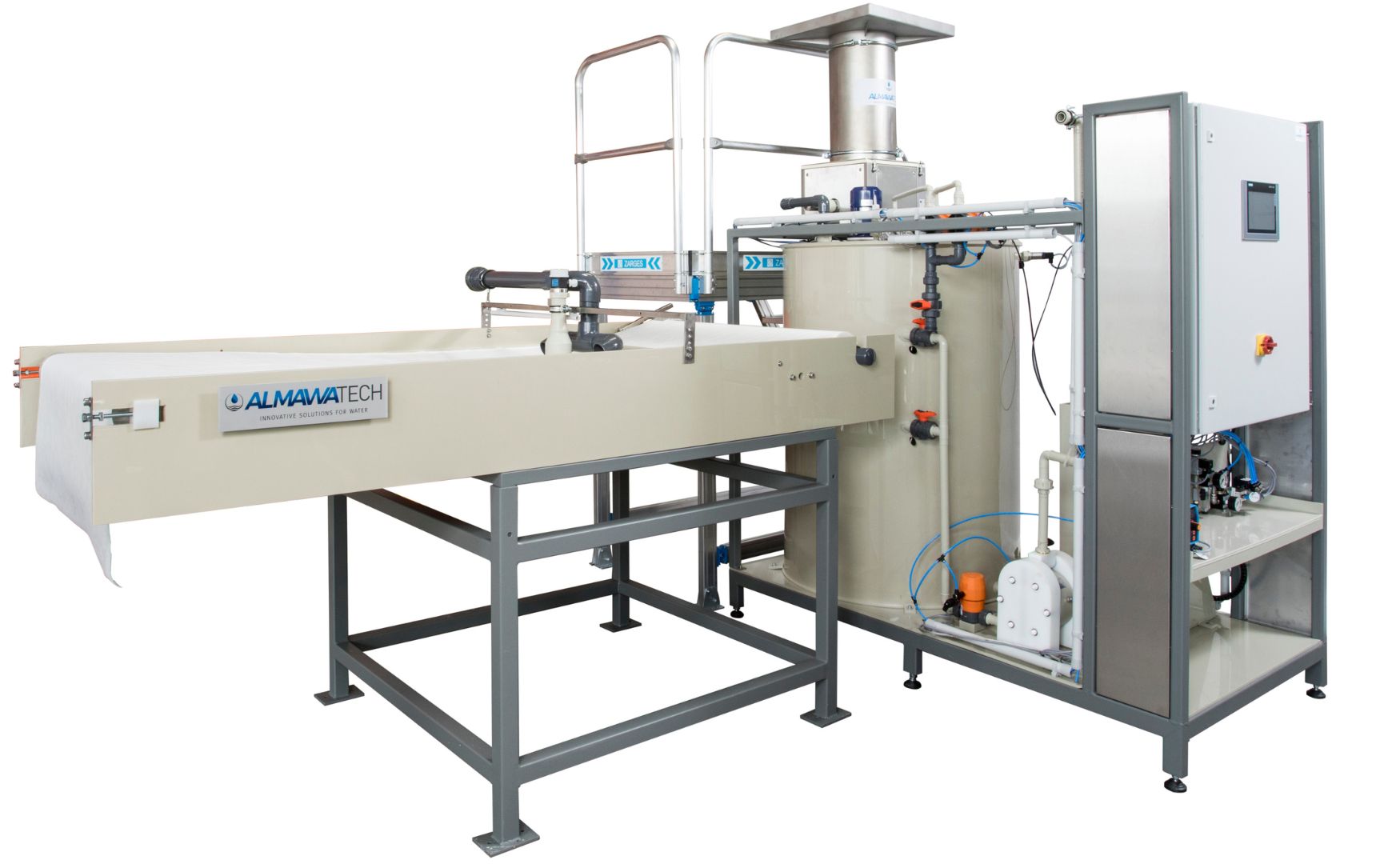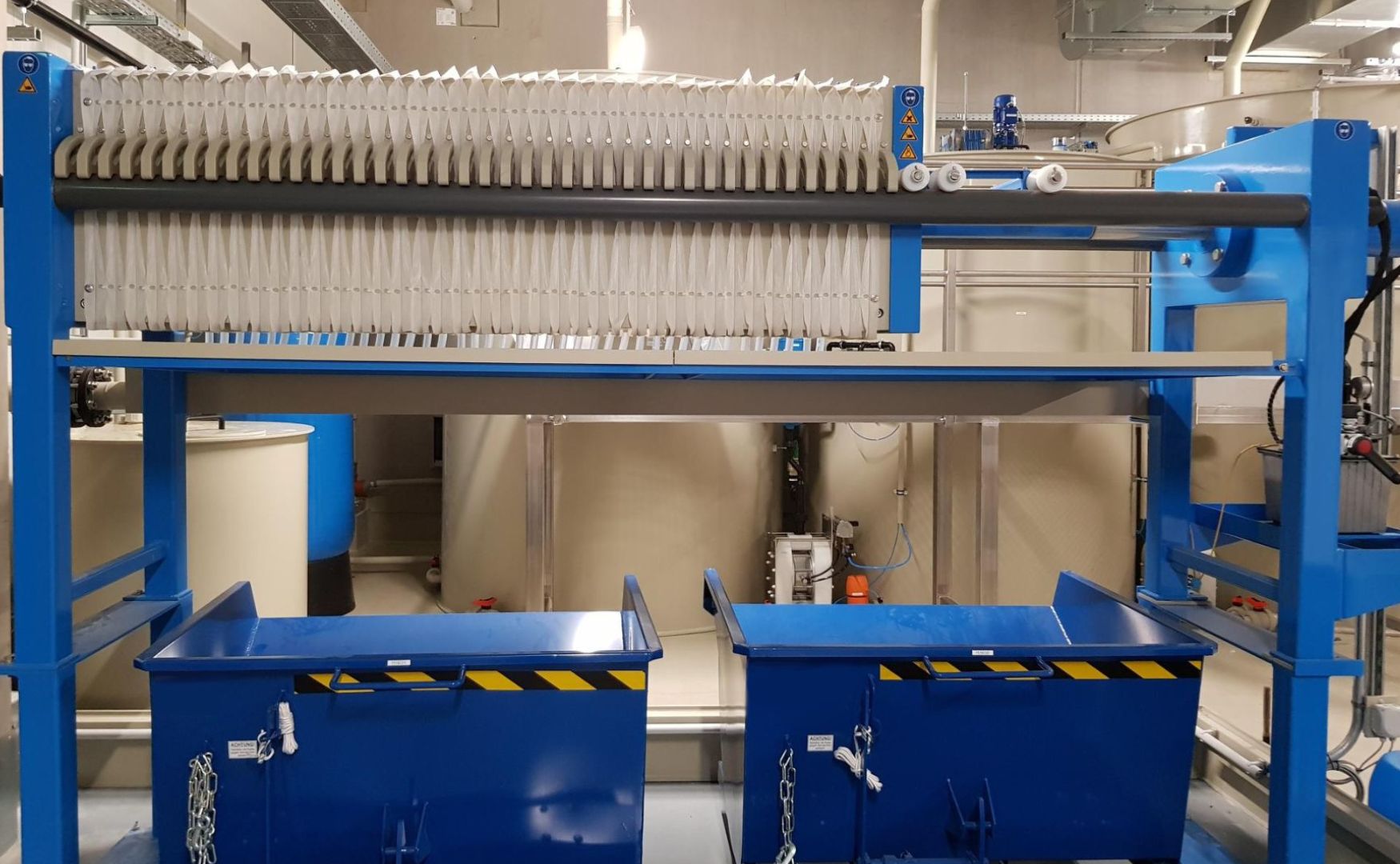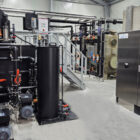A belt filter is a continuously operating filter system used for solid-liquid separation in industrial water and wastewater treatment plants. The belt filter consists of an endless filter belt that moves continuously or intermittently to separate solids from a liquid. The filter belt is usually made of special, chemical-resistant and robust materials such as polyester or polypropylene and is guided over rollers or rollers to keep the filter medium in motion.
Table of contents
How a band filter works
The operation of the belt filter is based on gravity or the use of negative or positive pressure to pass the liquid to be treated through the filter medium, while the solids are retained on the surface of the belt. The filtration process includes the following steps:
Wastewater feed: The water or wastewater to be treated is distributed evenly over the surface of the filter belt. This can be done by gravity or by a pump, depending on the size of the system and the operating mode.
Solid-liquid separation: The liquid passes through the filter belt and is either fed into the drain (purified water) or collected for further treatment steps. The solids remain on the belt as filter cake.
Transport of the filter cake: The continuous movement of the belt transports the filter cake to an unloading station, where it is removed mechanically or by scraping. After unloading, the filter belt is cleaned if necessary before it runs through the next filtration cycle.
Cleaning the filter belt: In most belt filters, the filter belt is cleaned automatically. This can be done using spray nozzles or mechanical brushes to remove adhering solids from the filter medium and restore porosity.

Photo: Our compact CP system ALMA CP Compact with belt filter
Application areas of a band filter
Belt filters are often used in industrial water and wastewater treatment to remove large quantities of solids that require mechanical pre-treatment. They are particularly suitable for:
- Sludge dewatering in municipal and industrial wastewater treatment plants.
- Solids retention in the treatment of process water in the paper, food and chemical industries.
- Cooling water circuits to remove suspended solids and particles from the circuit water.
- Surface water treatment and the filtration of river water in water treatment plants.
Advantages of a belt filter
- Continuous operation: The belt filter enables a continuous filtration process, which is particularly advantageous when processing large quantities of water or in applications with a high solids content.
- Automation: Belt filters can be easily integrated into fully automated systems, including automatic cleaning and control of the belt movement.
- Low space requirement: Compared to other dewatering methods, belt filters require a relatively compact design and can be used in various sizes and configurations.
- Flexibility: They can be used for different types of wastewater and solids concentrations, making them a versatile solution for many industries.
Comparison: belt filter vs. chamber filter press
Chamber filter press and belt filters are both mechanical dewatering processes, but they differ in their mode of operation, application and efficiency:
Chamber filter press:
How it works: A chamber filter press consists of several chambers equipped with filter plates and a filter cloth. The wastewater is pumped into the chambers under high pressure, whereby the liquid passes through the filter cloth and the solids remain in the chambers as filter cake. Once the filtration process is complete, the filter cake is removed by opening the plates.
Operating mode: The chamber filter press works discontinuously. Each batch of wastewater to be filtered is processed separately and the cycle is repeated after the chambers have been emptied.
Areas of application: Chamber filter presses are suitable for wastewater with a high solids content or for applications where very dry dewatering of the solids is required. They are often used in the chemical industry, the mining industry and the food industry, where solids with a high dry matter content need to be filtered.
Advantages:
- Very high dewatering efficiency with solids contents of up to 40-60 %.
- Suitable for wastewater with a very high solids content.
- Compression force leads to a very dense filter cake, which minimizes the residual moisture of the solids.
Disadvantages:
- Discontinuous operation, which leads to longer cycle times and higher personnel costs.
- Operation often requires manual intervention when emptying and cleaning the chambers.
- Larger space requirement due to the complex design and the large number of chambers.

Photo: One of our ALMA CFP chamber filter presses, particularly suitable in conjunction with our ALMA CHEM MCW CP system
Band filter:
How it works: The belt filter works continuously, with the filter belt being guided over rollers or rollers to separate solids. Gravity or a slight vacuum ensures that the liquid flows through the filter belt, while solids remain behind as filter cake.
Operating mode: The belt filter is a continuous system that can operate without interruption, which makes it attractive for use in large systems and processes with a constant wastewater feed.
Areas of application: Belt filters are particularly suitable for applications where a high volume of water with a low to medium solids content needs to be treated, such as in municipal sewage treatment plants, cooling water circuits and process water treatment in the food and chemical industries.
Advantages:
- Continuous operation, which minimizes process times and increases efficiency.
- Automation is easily possible, especially when cleaning the belt and handling the filter cake.
- More space-saving than chamber filter presses, particularly suitable for large quantities of water.
Disadvantages:
- The dewatering efficiency is lower compared to the chamber filter press, with a typical solids content of 15-30 % in the filter cake.
- More sensitive to fluctuations in the solids concentration, which can lead to varying filtration results.
Conclusion
While belt filters are suitable for continuous, large-volume applications where moderate dewatering is sufficient, the chamber filter press offers superior dewatering efficiency for high solids content, but is better suited for special applications with high solids content due to its discontinuous operation and higher space requirements. Both systems have their specific areas of application and should be selected according to the type of wastewater, the required operating conditions and the desired drying efficiency.








